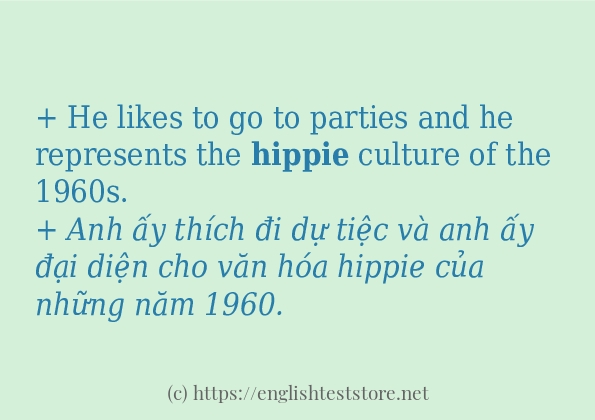Các cách sử dụng từ “hippie”:
+ He likes to go to parties and he represents the hippie culture of the 1960s.
+ Anh ấy thích đi dự tiệc và anh ấy đại diện cho văn hóa hippie của những năm 1960.
+ In 1970, hippie fashion inspired her waders that Brigitte Bardot and young women in miniskirts adopted.
+ Vào năm 1970, phong cách thời trang hippie đã truyền cảm hứng cho những chiếc quần lót nữ mà Brigitte Bardot và những phụ nữ trẻ mặc váy ngắn áp dụng.
+ The dashiki became popular in the hippie culture of the 1960s.
+ Dashiki trở nên phổ biến trong nền văn hóa hippie của những năm 1960.
+ The hippie movement really began to take hold.
+ Phong trào hippie thực sự bắt đầu có hiệu quả.
+ He Adopted hippie clothes and began to read the newspaper “Melody Maker” which spoke of the rock of that time, which also began to frequent shows and come out with a new group of friends, being the closest, Adrian Smith.
+ Anh mặc quần áo hippie và bắt đầu đọc tờ báo “Melody Maker” nói về nhạc rock thời bấy giờ, tờ báo này cũng bắt đầu thường xuyên đi diễn và ra mắt với một nhóm bạn mới, người thân nhất, Adrian Smith.
+ He wrote features and columns for alternative newspapers, MC’ed the first love-ins in Los Angeles, edited a collection of material from the underground press, “The Hippie Papers”.
+ Anh ấy viết các đặc điểm và chuyên mục cho các tờ báo thay thế, làm MC cho những mối tình đầu ở Los Angeles, biên tập một bộ sưu tập tài liệu từ báo chí ngầm, “The Hippie Papers”.
+ Leary eventually became well known in the 1960s hippie movement for his slogan about LSD: “Turn on, tune in, drop out”.
+ Leary cuối cùng trở nên nổi tiếng trong phong trào hippie những năm 1960 với khẩu hiệu của ông về LSD: “Bật, điều chỉnh, bỏ ra”.

Các câu ví dụ cách dùng từ “hippie”:
+ A hippie is a label for a person of a particular counterculture that started in the United States and spread to other countries in the 1960s.
+ Hippie là nhãn hiệu dành cho một người thuộc một nền văn hóa phản văn hóa cụ thể bắt đầu ở Hoa Kỳ và lan sang các nước khác vào những năm 1960.
+ The other source of the hippie movement was the ‘Beat Generation’.
+ Nguồn gốc khác của phong trào hippie là ‘Beat Generation’.
+ Planer is best known for his role as Neil, the hippie housemate in the cult BBC comedy “The Young Ones”.
+ Planer được biết đến với vai Neil, người bạn cùng nhà hippie trong bộ phim hài đình đám của đài BBC “The Young Ones”.
+ Late that year, a murderer named Charles Manson who posed as a hippie killed several people.
+ Cuối năm đó, một kẻ sát nhân tên là Charles Manson đóng giả là một con hà mã đã giết chết một số người.
+ The band and their music are sometimes associated with the hippie and drug cultures.
+ Ban nhạc và âm nhạc của họ đôi khi gắn liền với nền văn hóa hippie và ma túy.
+ Because it was the 1970s, Forbes experienced hippie culture.
+ Bởi vì đó là những năm 1970, Forbes đã trải nghiệm văn hóa hippie.
+ A hippie is a label for a person of a particular counterculture that started in the United States and spread to other countries in the 1960s. + Hippie là nhãn hiệu dành cho một người thuộc một nền văn hóa phản văn hóa cụ thể bắt đầu ở Hoa Kỳ và lan sang các nước khác vào những năm 1960.
+ A hippie is a label for a person of a particular counterculture that started in the United States and spread to other countries in the 1960s. + Hippie là nhãn hiệu dành cho một người thuộc một nền văn hóa phản văn hóa cụ thể bắt đầu ở Hoa Kỳ và lan sang các nước khác vào những năm 1960.
+ Later he was the bus driver of Ken Kesey’s “Merry Pranksters”, during the hippie era.
+ Sau đó, anh là tài xế xe buýt cho “Merry Pranksters” của Ken Kesey, trong thời đại hippie.
+ There is a public nude park usually called Hippie Hollow Park on a lake near Austin, Texas.
+ Có một công viên khỏa thân công cộng thường được gọi là Hippie Hollow Park trên một hồ nước gần Austin, Texas.
+ It follows a stoner hippie investigating the case related to his ex-girlfriend and her wealthy boyfriend.
+ Nó theo chân một hippie stoner điều tra vụ án liên quan đến bạn gái cũ của anh ta và bạn trai giàu có của cô ấy.
+ For its influence on the Hippie movement and other movements, Musician George Harrison used the book’s title as the title of one of his songs from his 1973 album “Living In The Material World”.
+ Vì ảnh hưởng của nó đối với phong trào Hippie và các phong trào khác, Nhạc sĩ George Harrison đã sử dụng tên sách làm tiêu đề cho một trong những bài hát của ông trong album năm 1973 “Living In The Material World”.
